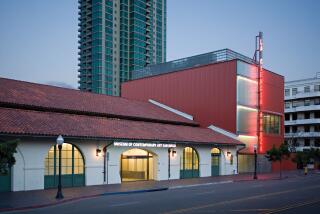KOMAC CASE REFLECTS ON ART AT SDSU
SAN DIEGO â âI guess it was just time for me to get out of San Diego,â said Dennis Komac, former director of the San Diego State University Art Gallery, after having had time to reflect on his situation and find another job.
In April, many in the San Diego art community were shocked to learn that SDSU would not renew Komacâs contract. Not least surprised was Komac himself.
He had been director of the gallery for six years and his contract had been renewed annually. He expected it to be renewed again in 1985. On other state university campuses, such as Long Beach State, gallery directors hold tenured positions.
As required by the state university system, the position was advertised and candidates interviewed by an elected departmental personnel committee. Finalists included Komac and one other candidate.
The committee, which enjoyed decision-making autonomy, was chaired by Janet Brody Esser, an art historian with a Meso-American specialty. It included other specialists, but Komac found it unusual that neither painters nor sculptors had been included on the committee.
Esser, who emphasizes the confidentiality of the committeeâs deliberations, will comment only that, âWe had a charge to find the best possible person for the post, and we are convinced that we did.â
Tina Yapelli was selected as the new director of SDSUâs gallery. She completed her work for a masterâs in art exhibition design and a Certificate of Museum Studies at California State University-Fullerton last year. She was a curatorial assistant at the Long Beach Museum of Art from June 1984 until she came to SDSU in June.
The SDSU gallery âwill continue to focus on exhibitions of contemporary art by regional, national and international artists,â said Yapelli. The gallery also has related interdisciplinary activities.
The chagrin of what Komac called a âfiringâ was quickly mitigated for him by the offer of a prestigious job as chief curator of the Grand Rapids (Michigan) Art Museum. He left San Diego on Aug. 14 for his new position.
Komac became director of the SDSU art gallery in 1979 after five years as curator of exhibitions at the San Diego Museum of Art, under then-director Henry Gardiner. At SDSU he followed Larry Urrutia, distinguished former curator of the La Jolla Museum of Contemporary Art, who created the SDSU gallery and, along with art activists Danah Fayman and Isabelle Wasserman, initiated formation of the Art Council, a fund-raising support group.
Since the gallery is not a collecting institution, Komac concentrated on developing quality exhibitions and catalogues.
Komacâs ambition for the gallery was to make it an educational resource for the campus by exhibiting works of significant artists, in addition to those of the faculty, and providing students with quality visual arts information. To realize those goals, Komac estimates that he and the Art Council raised $175,000 for exhibits during his six yearâs as director.
A few of the nationally known artists whose work he brought to SDSU are Vito Acconci, Mary Miss, Eric Orr, Billy Al Bengston and Ronald Davis. Their work would not have been seen in any depth in this area had it not been for the SDSU gallery. Nor would that of well known Los Angeles artists such as Paul Knotter, Jill Giegerich, David Amico, John Mandel, Lita Albuquerque and Wade Saunders, whose reputations are now expanding beyond the Southern California region.
Komac also helped many San Diego artists develop their careers, including Richard Baker, Patricia Patterson, Faiya Fredman, Barbara Strassen, Heidi Hardin and Christine Oatman.
Wasserman said, âOne of Dennisâ major contributions was as a bridge between San Diego and Los Angeles (arts communities). Weâll miss him greatly in that area. He was an educator able to convey his appreciation and sensitivity to others.â
Before departing for Grand Rapids, Komac said, âI love San Diego and believe in its future as an important art center. After 20 years I have strong emotional and professional ties to the city. But I am looking forward to a new kind of experience.â
As to the future of art here, Komac advised, âSan Diego needs to move ahead in terms of its visual arts sophistication. It needs to appreciate itself more than it has in the past. A city of this size must become serious in addressing the issues of its cultural institutions, their management and governance. Residents of the city cannot have the attitude of transients toward their arts institutions. They should appreciate their art professionals and support them, not ridicule them as they did over the Ellsworth Kelly commission. Art decisions need to be depoliticized.
âOn the other hand, San Diego museum people have the public trust and must maintain standards. They must have strong, valid credentials. San Diego must demand and expect honesty in the arts, as in other aspects of its civic life.â
About Komacâs departure, Wasserman said, âIt wasnât a question of his abilities, it was almost accidental. Most of the faculty supported Dennis. Everyone was upset, but the council exists to support the institution, not a particular director.â
Art Department Chairman Fred Worth added, âIt was a faculty decision, and I canât comment on that. Weâre pleased Dennis got a good job. He did a good job here, and he has many friends and supporters in the department.â
More to Read
The biggest entertainment stories
Get our big stories about Hollywood, film, television, music, arts, culture and more right in your inbox as soon as they publish.
You may occasionally receive promotional content from the Los Angeles Times.









